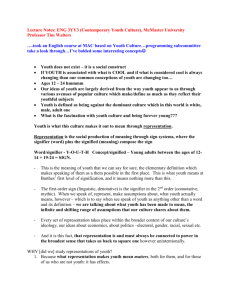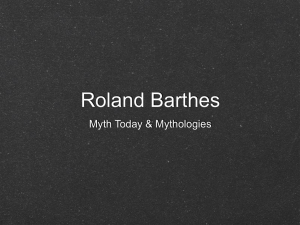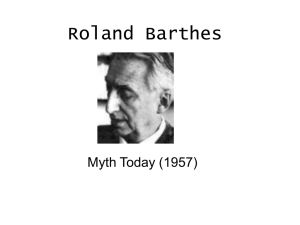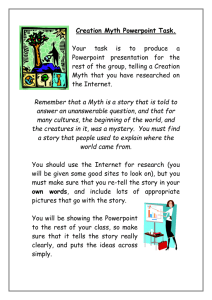Explanation of “Myth Today” from Roland Barthes's Mythologies
advertisement
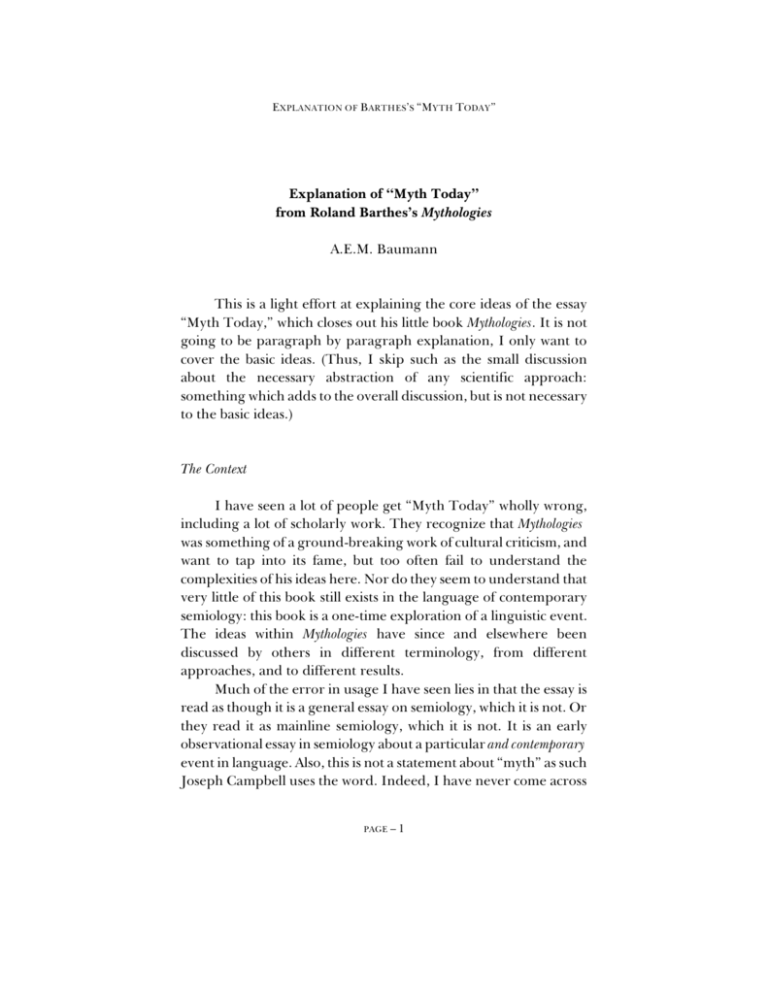
EXPLANATION OF BARTHES’S “MYTH TODAY”
Explanation of “Myth Today”
from Roland Barthes’s Mythologies
A.E.M. Baumann
This is a light effort at explaining the core ideas of the essay
“Myth Today,” which closes out his little book Mythologies. It is not
going to be paragraph by paragraph explanation, I only want to
cover the basic ideas. (Thus, I skip such as the small discussion
about the necessary abstraction of any scientific approach:
something which adds to the overall discussion, but is not necessary
to the basic ideas.)
The Context
I have seen a lot of people get “Myth Today” wholly wrong,
including a lot of scholarly work. They recognize that Mythologies
was something of a ground-breaking work of cultural criticism, and
want to tap into its fame, but too often fail to understand the
complexities of his ideas here. Nor do they seem to understand that
very little of this book still exists in the language of contemporary
semiology: this book is a one-time exploration of a linguistic event.
The ideas within Mythologies have since and elsewhere been
discussed by others in different terminology, from different
approaches, and to different results.
Much of the error in usage I have seen lies in that the essay is
read as though it is a general essay on semiology, which it is not. Or
they read it as mainline semiology, which it is not. It is an early
observational essay in semiology about a particular and contemporary
event in language. Also, this is not a statement about “myth” as such
Joseph Campbell uses the word. Indeed, I have never come across
PAGE
–1
EXPLANATION OF BARTHES’S “MYTH TODAY”
this particular usage of the word myth except in relation to this book
(which, I believe, is part of the point, since “myth” as such a
Campbell and Eliade use the word is in a kind of functional opposition
to “myth” as Barthes is describing). This essay is social commentary,
a statement on how cultural thinking has become something less than
mythic in the more quotidian sense, has become something less alive,
and the language chosen works to that end.[FN] This book is, after
all, as Barthes states in the Preface, “an ideological critique bearing
on the language of so-called mass-culture.”
********************************
[FN] That is a problematic statement, as the language
which Barthes is describing has never not been, nor,
arguably, in the cultural domain, never not been the
dominant modality of thought. But in the context of the
moment, Barthes is saying that the other mythical
thinking has been greatly reduced because of
consumerist mass-culture.
********************************
For example, the opening sentence: What is myth, today? The
context – and the irony inherent – is already established. If you
need more, though, the opening sentence on the very next page
(page 110 in the 1972 HarperCollins edition, Annette Lavers,
trans.):
Naturally, everything is not expressed at the same time:
some objects become the prey of mythical speech for a
while, then they disappear [. . .]. (emphasis mine)
Seems rather obvious that the approach is not neutral, that
“mythical speech” is not here being considered as a cultural positive.
And then, at the end of the paragraph
Ancient or not, mythology can only have an historical
foundation, for myth is a type of speech chosen by
history: it cannot possibly evolve from the ‘nature’ of
things.
and the intended contrast between mythical speech of the past and
of the present is wholly demarked. The “mythical speech” of
Barthes’s essay is of a continuum with the “mythical speech” of
PAGE
–2
EXPLANATION OF BARTHES’S “MYTH TODAY”
previous times, only “today” it has a different nature, a nature that
is of its historical moment (i.e., the historical era of Western
consumer capitalism and ideological reification.)
Signifier, Signified, Sign
As this is a presentation of a semiological event, Barthes starts
at the basics: the triad of signifier, signified, and sign, the last being
“the associative total of the first two” (113). If you are unfamiliar
with these terms, I believe the easiest way to get a grasp of them is
to not try to make something complicated out of them. They are very
simple ideas. Barthes’s example of the use of roses is about as good
an explanatory example as can be had.
I secretly put some roses on a person’s work desk to express
my passion for that person. The roses, the material object of the
roses, is the signifier. The idea which I am using the roses to convey
is the signified. I want this thing to speak this idea. Two different
things. That part’s simple. The difficulty comes with the sign which
is nothing other than a word to designate the union of the two. To
speak of the sign is to speak of the whole of the act, both the material
and ideational aspects unified as one thing.[FN]
********************************
[FN] I will use the word material here consistently,
though a signifier need not be strictly material, as with
myth, which uses signs as signifiers. Or, if I am
brainstorming, the signs I am conveying to myself may
have a non-material signifier. However, the word
materiality functions so well for a base definition, to help
create the basic ideas, I will stick with using it in a very
broad sense. I am using the method of “if they get the
general idea, then they can readily handle the
variations.”
********************************
Calling something a “sign” is recognition that there is an
action to convey a signified through the signifier happening.
PAGE
–3
EXPLANATION OF BARTHES’S “MYTH TODAY”
Equally importantly is to note there can be no sign without such
recognition. If I were to put a stapler on the desk (for no reason
other than the desk was a convenient place to put it), there is a
material event, but it is not a signifier of any meaning, and there is
thus no sign. If I were to walk past the person’s desk and think my
passion for them (without any expression) there would be an idea,
but no conveyance via a signifier, and thus no sign.
Which speaks that the three work together. You cannot have
a sign without both signifier and signified. You cannot have a
signifier without a signified and both thus making a sign, etc.
That’s it. When I see people struggling with this idea it is
usually because they are trying to make something out of it far more
complex or profound. This is just a declaration of terms and their
association. Where it becomes important is wholly in the recognition
that the making of the sign is not itself material; that is, as Barthes
stated in the quotation just above, a sign does not evolve from the
nature of things. For example, it could be that putting a
marshmallow on a person’s desk is a playfully suggestive
complement as to the dress of the receiving person by a convention
which only those two people know. A sign need not be established
within a language; it need only be recognized as a sign by a person.
Because of that, if I were to put a stapler on a person’s desk as
a really poor choice of expression for conveying my passion for that
person, for me it might be a sign, but for the person it probably
would not, and be merely be a material act. Or, where it was a sign
carrying the signified of passion for me, it might (if the person
happened to be looking for a stapler at that time) be a sign of
considerateness. Or, if I put the stapler down merely to free up my
hand for a moment, it could be for the other person a sign of my
mental awareness and caution. Or, if I put the stapler down to free
up a hand and forgot it, and the person was a person with a semipsychotic crush on me looking for any requiting of their emotions,
there could yet again be a sign made of a material signifier with a
signified of passion.
That is why there is that third term sign: it recognizes that the
material element and the idea element are in themselves insufficient
PAGE
–4
EXPLANATION OF BARTHES’S “MYTH TODAY”
to making a sign. There has to be recognition of the act by a person.
The terminology applies the same way with language:
dachshund
Color (distinguishable from background color) set out in that
general shape is a material signifier conveying to the reader a
signified which will be found mostly within the denotations of the
English language. As such, when it operates as such, it is a sign. (In
truth, it is not a sign only when you are no longer seeing it as a word
but merely as a design.)
Myth: The Second-Order Semiological System
Also not so difficult to understand if you keep it simple. A
myth is a sign that has for its signifier not a material element but
another sign. Barthes uses a graphic made of boxes to visualize myth
as a sign – and I admit I find it curious he decided to descend down
the page rather than build up. Here I will be a little more algegraic.
A sign is the unity of a signifier and a signified:
SIGN #1
= {SIGNIFIER #1-SIGNIFIED #1}
A myth takes that sign and uses it as a signifier. As such a myth
is
SIGN #2
= {SIGN #1-SIGNIFIED #2}
or
SIGN #2 =
{{SIGNIFIER #1-SIGNIFIED #1}-SIGNIFIED #2}
which I admit does little to not make it look confusing. Just
remember a myth is a sign that uses a sign for its signifier. So it is a
level of meaning laid on top of or added to or, as Barthes is
demonstrating, suppressing the first level of meaning. Barthes calls
it metalanguage, because it a language act that uses language as its
PAGE
–5
EXPLANATION OF BARTHES’S “MYTH TODAY”
signifiers.[FN]
********************************
[FN] Do not confuse the “meta-” here with that found in
“metahumor” or “metatext,” which are related ideas but
need not be the same. For example, both words are
often used to describe events in a text like a film or book
where the text speaks its “awareness” that it is a film or
a book, as when it addresses the audience or reader. For
example: the Freudian slip scene in Annie Hall where
Alvy suddenly turns to the audience and say something
like “You heard it too, right? I’m not going crazy here.”)
********************************
On page 117 Barthes adds new terms to keep the first and
second level signs distinct in his discussion. He calls:
signifier#2
form
signified#2
concept (which he uses also for
signified#1 since they are functionally
the same)
sign#2
signification
So at the first level:
SIGN
= {SIGNIFIER -SIGNIFIED }
and at the second level
SIGNIFICATION
= {FORM -CONCEPT }
Again, the easiest way to confusion is to make something of this
other than “let me call these this to make it easy to tell them apart”
(because we will see that a when a sign becomes a form it changes).
While the words chosen are ultimately chosen for a reason, he could
have as easily called them “Tom, Dick, and Harry.” In the
discussion below I will stick to the three basic terms, using modifiers
to make clear the level of signification. However, while reading
through Barthes text – as with any text that is creating its own
vocabulary – it is helpful to simply make a chart of Barthes’s
PAGE
–6
EXPLANATION OF BARTHES’S “MYTH TODAY”
diagram with the six terms and keep it beside you.
Barthes gives two examples of mythic language, of secondorder signs: the phrase in the Latin text book and the photo of the
soldier. Both choices are problematic. The first might throw some
people off because of bringing in a second language, and I have
found often throws people off because its is hard to see the sign as
a language object. The second will very surely throw off most
English readers because they won’t know the history behind the
picture: that of French imperialism and their conflicts in Algeria.
(The black soldier is by implication Algerian.) So let me give you two
new examples, each of the same nature.
The grammatical:
I look in my English style manual and grammatical and find
this:
the babies’ toys
On the first level of signification, it is a material signifier that carries
a signification, simply because it is a written, English phrase. It is a
sign with the signifier constituted of the printed letters and a
signifier found in the conventions and definitions of English. But it
is being used within my grammar book as an example of how to use
the possessive apostrophe with a plural noun ending in -s. The sign
that is the phrase is also the signifier of a second-level sign whose
signified is “the possessive apostrophe goes after the s with plural
nouns ending in s.” You can’t have that second-level of meaning if
you don’t have that first sign. If the grammar book had put as its
example
dkfu wlen’x wng
it rather would not carry the intended signification. There is no
second level signification (“this is an example for a grammar rule”)
because there is no first level signification (created by the use of
English).
Second example:
Instead of a black French soldier let’s have instead a picture of
a U.S. soldier in a wheel chair saluting a U.S. flag. Even better, let’s
have a line of veterans in wheel chairs saluting a flag with a banner
PAGE
–7
EXPLANATION OF BARTHES’S “MYTH TODAY”
naming the local V.A. hospital across the front. The second-level
signification that culture has attached to such a picture is one of the
glory of the U.S. military and veterans still love their country and
how their country still loves them. How this meaning preys upon the
image is that it is a meaning intended to suppress what might be
any first level, individual engagements with the image: for example,
that V.A.’s seem to be, across the U.S., rather poor in comparison
to even local hospitals, and then, as such, that the photo is a blatant
attempt to create positive ideas about a V.A. system that does not do
what it should. (Which is, then, seeing the myth for what it is.)
That is the basic idea of it, but to understand the idea in
context of the essay you have to circle back around to the front.
Many people get confused here in that they lose track of the greater
context, and get lost in the jump from “ok, I understand how a sign
can be a signifier” to “but what’s so important about that?” After all,
language is not linear. If you imagine an archaeologist coming upon
a never-before-seen text, recognizing the presence of the first-order
sign of the “the babies’ toys” phrase above could cue the “secondorder” sign of the text being a grammar example, which could cue
another “second-order” sign that the whole of the text is a
grammatical, and if the moment was the opening scene of a movie
showing only a person working at a desk, it could then cue yet
another “second-order sign” that the man is in fact an archaeologist
exploring a new-found text.
Thus the first point we must go back and remember: That’s
the thing about signs and language: signs are not derived from the
nature of things. The material object itself does not make a sign. As
such, second-order myths as Barthes is discussing are signs attached
to things, and, even, could be signs that are at odds with the firstorder signs they are suppressing. Language may be said to have
orders, but that is an abstraction created solely for the its usefulness
in the discussion of signs and “Myth Today.” (To note, the idea of
second-signs does continue in semiology.)
Which leads directly to the second point we need to go back
and remember: re-establishing the context of the essay and
PAGE
–8
EXPLANATION OF BARTHES’S “MYTH TODAY”
Barthes’s approach to the subject matter of mythic language today,
that demonstrated in the other quotation above:
Naturally, everything is not expressed at the same time:
some objects become the prey of mythical speech for a
while, then they disappear [. . .]. (emphasis still mine)
Barthes is making a distinction between any loose idea of a “secondorder sign” (which happens all the time) and the particular instance
of such second-order signs that constitutes mythic speech today. He
is making a distinction between the various signs created with the
stapler – which are signs generated by the individuals – and myths,
which are signs which are attached to sign-signifiers not through the
individual’s engagement with the signifier but by culture. They are
external to the event. The even precede the event.
The various short essays in the book are examples of moments
where the individual’s engagement with the material event (that is,
their own individual meaning-explorations) is suppressed (whether
the viewer is cognizant of it or not, though usually the latter) by a
second-order cultural meaning. For an example, I need only the
first paragraph of “Striptease”:
Striptease – at least Parisian striptease – is based on a
contradiction: Woman is desexualized at the very
moment when she is stripped naked. We may therefore
say that we are dealing in a sense with a spectacle based
on fear, or rather on the pretence of fear as if eroticism
here went to further than a sort of delicious terror,
whose ritual signs have only to be announced to evoke at
once the idea of sex and its conjuration. (84, all emphasis
mine)
Notice how he contextualizes the event to a particular sociohistorical moment. He is not talking about the event of a striptease
universally. He is talking about how in Paris the event of striptease
– which is supposed to be erotic – has been suppressed by mythic
speech so that it is now based on fear, which is why the woman ends
up desexualized after performing an act that is at its core an overt
presentation of sexuality. It is a second-order sign in that that fear
exists – and can exist – only because the first-order sign is of the
PAGE
–9
EXPLANATION OF BARTHES’S “MYTH TODAY”
erotic. And it is because the second-order sign is no longer attached
to the materiality of a woman taking her clothes off that the “ritual
signs have only to be announced” to evoke the second-order
meaning of sexuality in that context of fear.
Continuing On . . .
The rest of the essay is explication of and elaboration upon
that basic idea – understood, of course, within the context of myth
as cultural speech. Here Barthes is flushing out both his
semiological presentation of “myth today” and – in the process – the
nature of the cultural commentary he is making about France (and
contemporary Western culture in general). As such, it is not necessary
to understanding the short essays that make up the rest of the book
in the context presented by the book as a whole. He is moving more
into advance theories of language. But recognize also he is not
talking an established science, he is flushing out these ideas for
themselves. As such, they are not perfect in their presentation.
It is worth the going through if you can manage it, though I
will admit it occasionally makes for difficult parsing. Keep in mind
while reading it this presentation is not carried outside this book
except through direct reference to this book. Which is not to say
there is anything incorrect, here. It is more to say that the science
of semiology rather approaches the matter through its own more
established terms than through Barthes’s. Also, keep in mind this
was written in 1957, and is something of a first go at the ideas being
presented. (Even in his own Elements of Sumiology, which is 1964, he
has greatly changed his language and presentation.) I will give but
very brief summary/notation, organized by Barthes’s headers.
The form and the concept: Describes what happens to the signifier
and signification as it moves from the first to the second order. The
signifier of the first order is suppressed by the myth when it
becomes the signifier (form) of the second order. It is emptied out
of meaning (though never wholly, or the myth could not exist).
PAGE – 10
EXPLANATION OF BARTHES’S “MYTH TODAY”
That emptiness is filled in by the second-order concept – which does
function exactly as the first-order concept: it gives meaning. What
is important about myth is that it is putting meaning upon a
signifier that already had meaning. It is suppressing the first
meaning in favor of the second.
The signification: Perhaps the most important moment of the
section comes early:
However paradoxical it may seem, myth hides nothing: its
function is to distort, not to make disappear. There is no
latency [in Freudian terms] of the concept in relation to
the form: there is no need of an unconscious in order to
explain myth. (121, emphasis his for once)
There is also this moment:
What the concept distorts is of course what is full, the
meaning: the lion and the Negro are deprived of their
history, changed into gestures. (122, emphasis mine)
I cannot help but recognize how this becomes the reiterative
performance of culture (which is to say performed re-affirmation of
the truths of culture) in later thinkers like Mary Douglas and Judith
Butler.
One more, since it’s a long section and I’m only doing
indicative quotations:
The mythic signification [. . .] is never arbitrary; it is
always in part motivated, and unavoidably contains some
analogy. (126)
Which may be a statement Barthes himself might reject later on in
that signs are always “arbitrary” in the sense that they are never
inherent to the signifier – whether it is first-order or second-. But
recognizing that to a degree far greater than first-order signs,
second-order myths are motivated: they serve a purpose, which is the
self-maintenance of the constancy of mass-culture (a language
Barthes doesn’t use) in all its aspects, including promoting – as with
the myth attached French soldier – national chauvinism (and thus
social stability).
PAGE – 11
EXPLANATION OF BARTHES’S “MYTH TODAY”
Reading and deciphering myth: A section which is as much about
how myths function as how to see through myths, and as such we
come to a key sentence that is another turn back to the beginning:
We reach here the very principle of myth: it transforms
history into nature. (129)
I break the passage in two because what follows is more technical,
and that sentence deserved to be isolated.
We now understand why, in the eyes of the myth-consumer,
the intention, the adhomination of the concept, can
remain manifest without however appearing to have an
interest in the matter: what causes mythical speech to be
uttered is perfectly explicit, but it is immediately frozen
into something natural; it is read not as a motive but as
a [rational] reason. (129, emphasis his)
“Adhonimation” as in ad hominem, appeal to emotions rather
than reason; attacking character rather than the actual argument.
A myth is not meant to function – nor does it function – with the
discourse of language like first-order signs. Where language at the
first-order is language about reality but not derived directly from the
nature of reality, myth strives to establish just that connection.
Myth’s concepts are generated through “adhomination” – through
the emptying of meaning of the original signifier in place of a new,
emotionally based, cultural concept. But it conceals that artificiality
by “freezing” the language moment into a fixed meaning (Derrida
would call it sedimentation, in an important reversal of type of
energy involved, from the active to the passive). In freezing the
concept of the myth it creates validity for the concept, it creates a
stability that gives the impression of being derived from the nature of
things, thus validating the reality of the concept (even though the
concept is wholly artificial) and hiding the motivation of the concept
behind that mask of veracity. (What Barthes describes in Criticism
and Truth as versimilitude.)
Barthes describes the event well at the end of the paragraph
(speaking again about the photograph of the soldier):
[F]or the myth-reader [i.e., the believer of myth] the
outcome is quite different: everything happens as if the
PAGE – 12
EXPLANATION OF BARTHES’S “MYTH TODAY”
picture naturally conjured up the concept, as if the
signifier gave a foundation to the signified: the myth exists
from the precise moment when French imperiality
achieves the natural state [. . .]. (129-30, emphasis his)
This is the key element of myth’s function: it serves to create truths.
As Barthes says at the close of the section:
[A]ny semiological system is a system of values; now, the
myth-consumer takes the signification for a system of
facts: myth is read as a factual system, whereas it is but a
semiological system. (131)
When Derrida takes this us, he is describing the same idea
though from a different approach: that language and culture
naturally “freezes” or sediments, that language as not speaking
reality is and active engagement only: it is the nature of the mass to
believe language as truths. To note, Berger’s The Sacred Canopy is a
very good presentation of how this functions in religion. (Though,
many other books speak it less technically, as with Eliade’s The
Sacred and the Profane.)
I’ll stop here. What follows from that point on is mostly
cultural and political application of the ideas developed to this
point. Indeed, much of what follows Myth as a stolen language (131)
can be read without the advanced class in semiology. Keep in mind,
however, the more is subject is of culture, the more it is anchored
in his place and time. For example, you cannot take is comments on
poetry and apply it to the whole of the genre. He is speaking
critically about a very specific body of literature. (Though, to be
honest, even then I don’t bite on that hook.)
PAGE – 13
